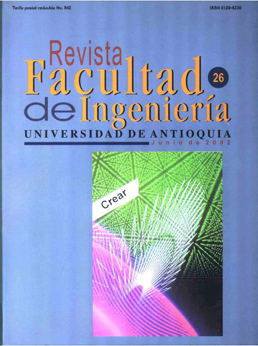Casos de uso como técnica para especificar el comportamiento de un sistema
DOI:
https://doi.org/10.17533/udea.redin.326378Palabras clave:
Requisito, actor, escenario, inclusión, extensión, generalización.Resumen
Los casos de uso son una técnica para la especificación de requisitos funcionales propuesta inicialmente en [ 1] y que actualmente forma parte de la propuesta de UML [2].
Los casos de uso están incluidos en el lenguaje unificado de modelamiento (UML) y se utilizan completamente en el Rational Unified Process. Hoy en día han alcanzado gran aceptación en muchos negocios e industrias. Más aún, los casos de uso se aplican a proyectos de software y a una gran variedad de aplicaciones industriales. Se utilizan para especificar los requisitos externamente visibles de un sistema. Se usan en la fase de ingeniería de requisitos y contribuyen a establecer planes de chequeo y guías de usuario. Adicionalmente, se utilizan para crear y validar un diseño propuesto y asegurar que este diseño se ajusta a todos los requisitos.
En este artículo se quiere presentar un panorama acerca de lo que son los casos de uso, sus componentes y cómo identificarlos, cómo se relacionan, cómo se identifican y como aplicarlos en un ejemplo concreto.
Descargas
Citas
l. Jacobson, M. Christerson, P. Jonsson y G Övergaard. Object-Oriented Software Engineering: A Use case Driven Approach. Addison-Wesley, 4ª. edición, 1993.
G Booch, J. Rumbaugh, y l. Jacobson. The Unified Modeling Language User Guide. Addison-Wesley, 1999.
M. Fowler y K. Scott. UML Distilled. Second Edition. Addison-Wesley, 2000.
D. F. D'Souza y A. C. Wills. Objects, Components, and Frameworks with UML: The Catalysis Approach. Addison-Wesley, 1999.
K. Weidenhaupt, K. Pohl, M. Jarke, y P. Haumer. Scenarios in System Delopment: Current Practice. IEEE Software, 15(2):34-45, marzo/abril, 1998. DOI: https://doi.org/10.1109/52.663783
D. G Firesmith. Use Cases: the Pros and Cons, 1997. Disponible en http://www.ksccary.com/article7.htm.
Schmuller, Joseph. Aprendiendo UML en 24 horas. Prentice-Hall. 1999.
A. Cockburn. "Structuring Use Cases with Goals". Journal of Object-Oriented Programming, Septiembre, noviembre. y diciembre, 1997. Disponible en http:/ /members.aol.com/acockburn/papers usecases.htm.
D. Coleman. A Use Case Template: Draft for Discussion. Fusion Newslwtter, abril, 1998.
G Scheneider y J. P. Winters. Applying Use Cases: a Practical Guide. Addison-Wesley, 1999.
Descargas
Publicado
Cómo citar
Número
Sección
Licencia
Los artículos disponibles en la Revista Facultad de Ingeniería, Universidad de Antioquia están bajo la licencia Creative Commons Attribution BY-NC-SA 4.0.
Eres libre de:
Compartir — copiar y redistribuir el material en cualquier medio o formato
Adaptar : remezclar, transformar y construir sobre el material.
Bajo los siguientes términos:
Reconocimiento : debe otorgar el crédito correspondiente , proporcionar un enlace a la licencia e indicar si se realizaron cambios . Puede hacerlo de cualquier manera razonable, pero no de ninguna manera que sugiera que el licenciante lo respalda a usted o su uso.
No comercial : no puede utilizar el material con fines comerciales .
Compartir igual : si remezcla, transforma o construye a partir del material, debe distribuir sus contribuciones bajo la misma licencia que el original.
El material publicado por la revista puede ser distribuido, copiado y exhibido por terceros si se dan los respectivos créditos a la revista, sin ningún costo. No se puede obtener ningún beneficio comercial y las obras derivadas tienen que estar bajo los mismos términos de licencia que el trabajo original.










 Twitter
Twitter